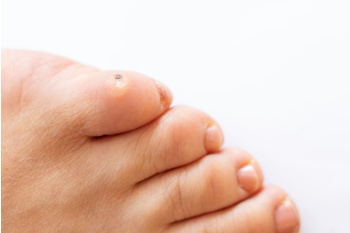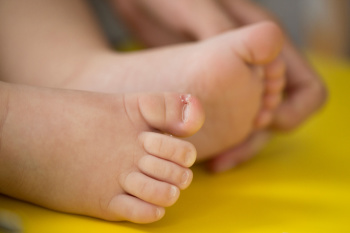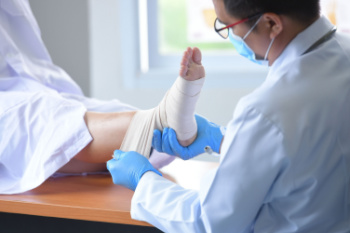
Corns and calluses are thickened areas of skin that develop as a natural response to repeated pressure or friction. Although they help protect the skin, they can become painful, especially when located on weight-bearing areas of the feet. Corns typically form on the tops or sides of toes and are often small and round. Calluses are usually larger and develop on the soles of the feet, especially under the heels or balls of the feet. Wearing tight shoes, walking barefoot, or having foot deformities like bunions can contribute to the formation of corns and calluses. While these skin changes are not harmful on their own, the discomfort they cause may affect walking and daily comfort. Treatment often includes reducing pressure through padding, wearing properly fitted footwear, and sometimes using custom orthotics. If corns or calluses are causing pain, it is suggested you visit a podiatrist for proper care.
If you have any concerns regarding your feet and ankles, contact one of our podiatrists of Gelbmann Podiatry. Our doctors will treat your foot and ankle needs.
Corns: What Are They? and How Do You Get Rid of Them?
Corns can be described as areas of the skin that have thickened to the point of becoming painful or irritating. They are often layers and layers of the skin that have become dry and rough, and are normally smaller than calluses.
Ways to Prevent Corns
There are many ways to get rid of painful corns such as wearing:
- Well-fitting socks
- Comfortable shoes that are not tight around your foot
- Shoes that offer support
Treating Corns
Treatment of corns involves removing the dead skin that has built up in the specific area of the foot. Consult with Our doctors to determine the best treatment option for your case of corns.
If you have any questions please feel free to contact our offices located in Chicago, IL . We offer the newest diagnostic and treatment technologies for all your foot and ankle needs.

An ingrown toenail occurs when the edge of the nail grows into the surrounding skin, causing irritation and discomfort. In children, this can be caused by improper nail trimming, wearing tight shoes, injuries, or inherited nail shapes. Symptoms include redness, swelling, pain along the nail edge, and sometimes drainage if an infection develops. Children may avoid walking or show signs of discomfort during activity. A podiatrist can gently lift or remove the ingrown portion, treat any infection, and provide guidance to prevent recurrence. Early care is important to avoid worsening symptoms. If your child is showing signs of an ingrown toenail, it is suggested that you schedule an appointment with a podiatrist to ensure safe, effective treatment and lasting relief.
Making sure that your children maintain good foot health is very important as they grow. If you have any questions, contact one of our podiatrists of Gelbmann Podiatry. Our doctors can provide the care you need to keep you pain-free and on your feet.
Keeping Children's Feet Healthy
Having healthy feet during childhood can help prevent medical problems later in life, namely in the back and legs. As children grow, their feet require different types of care. Here are some things to consider...
Although babies do not walk yet, it is still very important to take care of their feet.
Avoid putting tight shoes or socks on his or her feet.
Allow the baby to stretch and kick his or her feet to feel comfortable.
As a toddler, kids are now on the move and begin to develop differently. At this age, toddlers are getting a feel for walking, so don’t be alarmed if your toddler is unsteady or ‘walks funny’.
As your child gets older, it is important to teach them how to take care of their feet.
Show them proper hygiene to prevent infections such as fungus.
Be watchful for any pain or injury.
Have all injuries checked by a doctor as soon as possible.
Comfortable, protective shoes should always be worn, especially at play.
If you have any questions please feel free to contact our offices located in Chicago, IL . We offer the newest diagnostic and treatment technologies for all your foot and ankle needs.

Ankle fractures are common among seniors, often the result of falls related to poor balance, reduced strength, or slower reflexes. As people age, their bones become more fragile, which increases the chance of fractures from even minor missteps. In the geriatric population, ankle fractures can be more difficult to manage due to osteoporosis, thin skin, and poor circulation. This may slow healing and raise the risk of complications. Some ankle fractures may be treated without surgery if the bones remain stable, but more severe injuries may require surgery to restore alignment. Long periods of immobilization can be especially hard for seniors and may lead to issues such as ulcers, infections, or blood clots. A podiatrist will evaluate the ankle fracture, review health conditions that could affect healing, and help determine the best treatment to reduce pain and support recovery. If you believe you have sustained an ankle injury, it is suggested that you promptly schedule an appointment with a podiatrist for an exam and appropriate treatment options.
Broken ankles need immediate treatment. If you are seeking treatment, contact one of our podiatrists from Gelbmann Podiatry. Our doctors can provide the care you need to keep you pain-free and on your feet.
Broken Ankles
A broken ankle is experienced when a person fractures their tibia or fibula in the lower leg and ankle area. Both of these bones are attached at the bottom of the leg and combine to form what we know to be our ankle.
When a physician is referring to a break of the ankle, he or she is usually referring to a break in the area where the tibia and fibula are joined to create our ankle joint. Ankles are more prone to fractures because the ankle is an area that suffers a lot of pressure and stress. There are some obvious signs when a person experiences a fractured ankle, and the following symptoms may be present.
Symptoms of a Fractured Ankle
- Excessive pain when the area is touched or when any pressure is placed on the ankle
- Swelling around the area
- Bruising of the area
- Area appears to be deformed
If you suspect an ankle fracture, it is recommended to seek treatment as soon as possible. The sooner you have your podiatrist diagnose the fracture, the quicker you’ll be on the way towards recovery.
If you have any questions, please feel free to contact our offices located in Chicago, IL . We offer the newest diagnostic and treatment technologies for all your foot care needs.

Custom orthotics can be used to relieve foot pain and discomfort. They're also used to treat various foot conditions and deformities. Flat feet, bunions, and Morton's neuroma are just a few of the foot conditions that have been known to benefit from the use of orthotics.
Comfy feet are happy feet! Contact us today.

